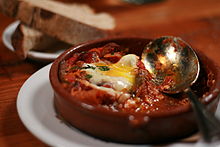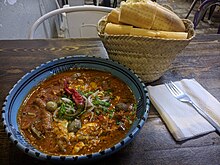This is an old revision of this page, as edited by LEvalyn (talk | contribs) at 01:54, 20 April 2024 (fix cite). The present address (URL) is a permanent link to this revision, which may differ significantly from the current revision.
Revision as of 01:54, 20 April 2024 by LEvalyn (talk | contribs) (fix cite)(diff) ← Previous revision | Latest revision (diff) | Newer revision → (diff) Maghrebi dish of eggs poached in a sauce For the shredded flatbread and chickpea dish, see Chakhchoukha. For the Turkish eggplant dish, see Şakşuka. For the documentary film, see The Shakshuka System. Shakshouka in a cast iron pan Shakshouka in a cast iron pan | |
| Alternative names | Shakshuka, chakchouka |
|---|---|
| Type | Main dish |
| Place of origin | Ottoman North Africa |
| Main ingredients | Tomatoes, harissa, eggs, olive oil |

Shakshouka (Template:Lang-ar : šakšūkah, also spelled shakshuka or chakchouka) is a dish of eggs poached in a sauce of tomatoes, peppers, onion, and olive oil. The earliest origins of the dish lie in peasant vegetable stews in Spain, which incorporated tomatoes and peppers after they were introduced to Europe via the sixteenth-century Columbian exchange. The stew spread to Tunisia in the seventeenth century, where poached eggs became a key ingredient. Tunisian Jews brought the dish to Israel in the 1950s, after which it became globally popular. A wide range of regional variations involve different ingredients for the base sauce or different accompaniments.
Origins
The name shakshouka derives from a Maghrebi Arabic verb for mixing or chopping. The starting place for the development of recipe is the introduction of tomatoes, a key ingredient, to the Mediterannean. Tomatoes became available in Europe beginning in the sixteenth century as part of the Columbian exchange, and spread to North Africa in the seventeenth century.
One possible origin, described by Gil Marks, traces shakshouka to the Ottoman Empire dish saksuka (Turkish for “goatee”), a stew of minced meat and cooked vegetables. When tomatoes and peppers arrived from America, Marks suggests, these were added to saksuka, which then spread throughout the Ottoman regions of Turkey, Syria, Egypt, the Balkans, and the Maghreb. In this lineage, it took on the name shakshuka in the Maghreb, where Maghrebi Jews eliminated the minced meat and (in Tunisia) added eggs.
More recently, Anthony Buccini has argued that shakshuka shares an origin in Spain with a wide variety of Western Mediterranean vegetable stews. Buccini’s account is now considered more likely. When tomatoes and peppers first arrived in Spain in the sixteenth century, they were not rapidly adopted by the upper classes — but, being easy to grow in Spain, they were eaten by the poor. The availability of these ingredients for peasant fare led to the development, in Spain, of a Western Mediterranean vegetable stew characterized by a base of onions cooked in olive oil, with tomatoes and usually peppers. In Europe, this stew spread from Spain under the names pisto, alboronía, cianfotta, xamfaina, and ratatouia, eventually leading also to the dishes piperade and uova in purgatorio (eggs in purgatory). The stew spread to North Africa with the Moriscos who were expelled from Spain between 1609 to 1614, who settled primarily in Tunisia but also in Morocco and Algeria. There, they introduced the stew as shakshouka. The similar Turkish dish menemen shares this origin.
By the nineteenth century, shakshouka had become established as a Tunisian dish consisting of a tomato and pepper stew with eggs. An 1871 French-Arabic dictionary provides the first published recipe for it, in the definition of shaqshūqa as a Tunisian Arabic term for “a dish composed of tomatoes, fresh peppers, and onions, with eggs on top.” The dish appeared as “Oeufs à la tunisienne” (Tunisian-style eggs) in an 1894 French cookbook. Other French recipes attributed the dish to North African, Egyptian, Arabian, and Turkish origins. Noam Sienna argues that these identifications are due to “a homogenizing Orientalism in the French colonial empire that did not bother to differentiate local cultures or contexts.” In the early twentieth century, multiple variations on shakshouka were included in early Jewish Tunisian cookbooks from 1907 and 1923.
In the 1950s, Tunisian Jews brought shakshuka to the newly-formed state of Israel, where it was embraced as part of a pan-Levantine Israeli culinary identity. In 1979, a cookbook aimed at soldiers in the Israel Defense Forces suggested making shakshuka as a way to deal with loof (a kosher canned corn beef), which formed an unbeloved part of the standard rations.(Raviv 172) Shakshouka began appearing in Israeli restaurants in the 1990s, and achieved global popularity in the twenty-first century. It spread to American and European brunch menus after featuring in Yotam Ottolenghi and Sami Tamimi's bestselling cookbook in 2012, and in 2018 the National Restaurant Association’s annual survey identified shakshuka as one of the next year’s “global food trends”. In its global spread, it is often described as an Israeli or Maghrebi Jewish dish.
Variations


Shakshouka is a popular dish throughout the Middle East and North Africa. Because eggs are the main ingredient, it often appears on breakfast menus in English-speaking countries, but in the Arab world as well as Israel, it is also a popular evening meal, and like hummus and falafel, is a Levantine regional favorite. On the side, pickled vegetables and North African sausage called merguez might be served, or simply bread, with mint tea.
The most basic essential of the recipe is cooking onions in olive oil, adding tomatoes, and then cooking eggs in the resulting sauce. Many variations of the basic sauce are possible, varying in spice and sweetness. Some cooks add preserved lemon, salty sheep milk cheeses, olives, harissa or a spicy sausage such as chorizo or merguez. Shakshouka is made with eggs, which are commonly poached but can also be scrambled, like in the Turkish menemen. Some variations of shakshouka can be made with lamb mince, toasted whole spices, yogurt and fresh herbs. Spices can include ground coriander, caraway, paprika, cumin and cayenne pepper. The North African dish matbukha can be used as a base for shakshouka.
In Algeria, shakshouka is commonly eaten as a side dish, with many variations. One such variation is hmiss, which is often served alongside traditional kesra bread. Hmiss typically includes grilled peppers, tomatoes, and garlic. In Tunisia, a similar dish called slata meshouia is enjoyed, but it differs from hmiss with the addition of onions, cumin and tuna. Tunisian cooks may add potatoes, broad beans, artichoke hearts or courgettes to the dish. In Jewish culture, a large batch of tomato stew is made for the Sabbath dinner and the leftovers used the following morning to make a breakfast shakshouka with eggs. In Andalusian cuisine, the dish is known as huevos a la flamenca; this version includes chorizo and serrano ham. In Italian cuisine, there is a version of this dish called uova in purgatorio (eggs in purgatory) that adds garlic, basil or parsley.
See also
References
- ^ Sienna, Noam (2021). "Shakshūka for All Seasons: Tunisian Jewish Foodways at the Turn of the Twentieth Century". In Gaul, Anny; Pitts, Graham Auman; Valosik, Vicki (eds.). Making Levantine Cuisine: Modern Foodways of the Eastern Mediterranean. University of Texas Press. p. 175.
- Buccini, Anthony F. (2006). Hosking, Richard (ed.). "Western Mediterranean Vegetable Stews and the Integration of Culinary Exotica". Authenticity in the Kitchen: Proceedings of the Oxford Symposium on Food and Cookery 2005: 132.
- Sienna, Noam (2021). "Shakshūka for All Seasons: Tunisian Jewish Foodways at the Turn of the Twentieth Century". In Gaul, Anny; Pitts, Graham Auman; Valosik, Vicki (eds.). Making Levantine Cuisine: Modern Foodways of the Eastern Mediterranean. University of Texas Press. p. 174.
- ^ Gil Marks, Encyclopedia of Jewish Food, Houghton Mifflin Harcourt, 2010, ISBN 9780470391303, s.v., p. 547
- ^ Buccini, Anthony F. (2006). Hosking, Richard (ed.). "Western Mediterranean Vegetable Stews and the Integration of Culinary Exotica". Authenticity in the Kitchen: Proceedings of the Oxford Symposium on Food and Cookery 2005: 142.
- Buccini, Anthony F. (2006). Hosking, Richard (ed.). "Western Mediterranean Vegetable Stews and the Integration of Culinary Exotica". Authenticity in the Kitchen: Proceedings of the Oxford Symposium on Food and Cookery 2005: 136.
- ^ Sienna, Noam (2021). "Shakshūka for All Seasons: Tunisian Jewish Foodways at the Turn of the Twentieth Century". In Gaul, Anny; Pitts, Graham Auman; Valosik, Vicki (eds.). Making Levantine Cuisine: Modern Foodways of the Eastern Mediterranean. University of Texas Press. p. 176.
- Marcelin Beaussier, Dictionnaire pratique arabe-français (Algiers: Imprimerie Bouyer 1871), 341. Translated and quoted by Noam Sienna, "Shakshūka for All Seasons: Tunisian Jewish Foodways at the Turn of the Twentieth Century", p. 176
- "Ménage". Le XIXe siècle : journal quotidien politique et littéraire. 12 August 1896.
La chakchouka est un mets égyptien.
- ^ Sienna, Noam (2021). "Shakshūka for All Seasons: Tunisian Jewish Foodways at the Turn of the Twentieth Century". In Gaul, Anny; Pitts, Graham Auman; Valosik, Vicki (eds.). Making Levantine Cuisine: Modern Foodways of the Eastern Mediterranean. University of Texas Press. p. 170.
- Sienna, Noam (2021). "Shakshūka for All Seasons: Tunisian Jewish Foodways at the Turn of the Twentieth Century". In Gaul, Anny; Pitts, Graham Auman; Valosik, Vicki (eds.). Making Levantine Cuisine: Modern Foodways of the Eastern Mediterranean. University of Texas Press. p. 175.
- ^ Sienna, Noam (2021). "Shakshūka for All Seasons: Tunisian Jewish Foodways at the Turn of the Twentieth Century". In Gaul, Anny; Pitts, Graham Auman; Valosik, Vicki (eds.). Making Levantine Cuisine: Modern Foodways of the Eastern Mediterranean. University of Texas Press. p. 177.
- ^ Fitzgerald, Mary (Apr 24, 2021). "Shakshuka: All mixed up over a brilliant breakfast". The Irish Times. Retrieved 2021-09-09.
- Salah, Maha (14 February 2020). "Shakshuka". Middle East Monitor.
- Clifford-Smith, Stephanie (2011-06-07). "Three of a kind ... shakshouka". Sydney Morning Herald. Archived from the original on 2017-08-08. Retrieved 2017-08-07.
- Josephs, Bernard (2009-10-08). "Shakshuka: Israel's hottest breakfast dish". The Jewish Chronicle. Archived from the original on 2017-08-08. Retrieved 2017-08-07.
- Ashkenazi, Michael (2020). Food Cultures of Israel: Recipes, Customs, and Issues. p. 89.
- Buccini, Anthony F. (2006). Hosking, Richard (ed.). "Western Mediterranean Vegetable Stews and the Integration of Culinary Exotica". Authenticity in the Kitchen: Proceedings of the Oxford Symposium on Food and Cookery 2005: 133–4.
- "Shakshuka recipe". The Guardian. February 18, 2012.
- Joel Lurie Grishaver (2008). Artzeinu: An Israel Encounter.
- Gordon, Peter (2018-06-03). "Peter Gordon's lamb shakshouka recipe". The Guardian. ISSN 0261-3077. Retrieved 2018-07-21.
- "Shakshouka Recipe – Tunisian Recipes". PBS Food. 2015-03-12. Retrieved 2018-07-21.
- Clark, Melissa. "Shakshuka With Feta Recipe". NYT Cooking. Retrieved 2018-07-21.
- Gur, Janna (2014). Jewish Soul Food: From Minsk to Marrakesh.
- Roden, Claudia (1996). The Book of Jewish Food: An Odyssey from Samarkand to New York. Knopf. p. 512. ISBN 9780394532585.
- Tish, Ben (2019). Moorish: Vibrant Recipes from the Mediterranean. Bloomsbury. p. 46. ISBN 9781472958082.
- "Uova in purgatorio". La Cucina italiana (in Italian). 20 August 2015. Retrieved 2023-06-24.
External links
 Quotations related to Shakshouka at Wikiquote
Quotations related to Shakshouka at Wikiquote
| Cuisine of Tunisia | |
|---|---|
| Breads, dishes, and soups | |
| Ingredients | |
| Beverages | |
| Desserts and pastries | |
| Related | |
| Algerian cuisine | |
|---|---|
| Dishes | |
| Soups | |
| Brochettes | |
| Ingredients | |
| Beverages | |
| Desserts and pastries | |
| Related | |
| Jewish cuisine | |||||||||||
|---|---|---|---|---|---|---|---|---|---|---|---|
| History | |||||||||||
| Types | |||||||||||
| Religious dietary laws and related terms | |||||||||||
| Chefs | |||||||||||
| Religious foods | |||||||||||
| Breads |
| ||||||||||
| Sweets |
| ||||||||||
| Pastries | |||||||||||
| Fried foods |
| ||||||||||
| Dumplings, pastas and grain dishes |
| ||||||||||
| Casseroles and savory baked dishes | |||||||||||
| Snacks and other baked goods | |||||||||||
| Sandwiches | |||||||||||
| Egg dishes | |||||||||||
| Meat dishes | |||||||||||
| Fish dishes | |||||||||||
| Salads and pickles | |||||||||||
| Vegetable dishes | |||||||||||
| Soups and stews | |||||||||||
| Cheeses and other dairy products | |||||||||||
| Condiments, dips and sauces | |||||||||||
| Beverages | |||||||||||
| Herbs, spices and seasonings | |||||||||||
| Eateries | |||||||||||
| Related lists | |||||||||||
| Moroccan cuisine | |
|---|---|
| Dishes (list) | |
| Brochettes | |
| Ingredients | |
| Soups | |
| Breads | |
| Desserts & pastries | |
| Beverages | |
| Related cuisines | |
- Arab cuisine
- Libyan cuisine
- Tunisian cuisine
- Algerian cuisine
- Moroccan cuisine
- Israeli cuisine
- Egyptian cuisine
- Yemeni cuisine
- Egg dishes
- National dishes
- Mizrahi Jewish cuisine
- Sephardi Jewish cuisine
- Maghrebi cuisine
- Ottoman cuisine
- Spanish cuisine
- Italian cuisine
- Meze
- Tomato dishes
- Breakfast
- Transatlantic cultural exchange
- Shabbat food
- Middle Eastern cuisine
- Berber cuisine
- Romani cuisine
- Palestinian cuisine